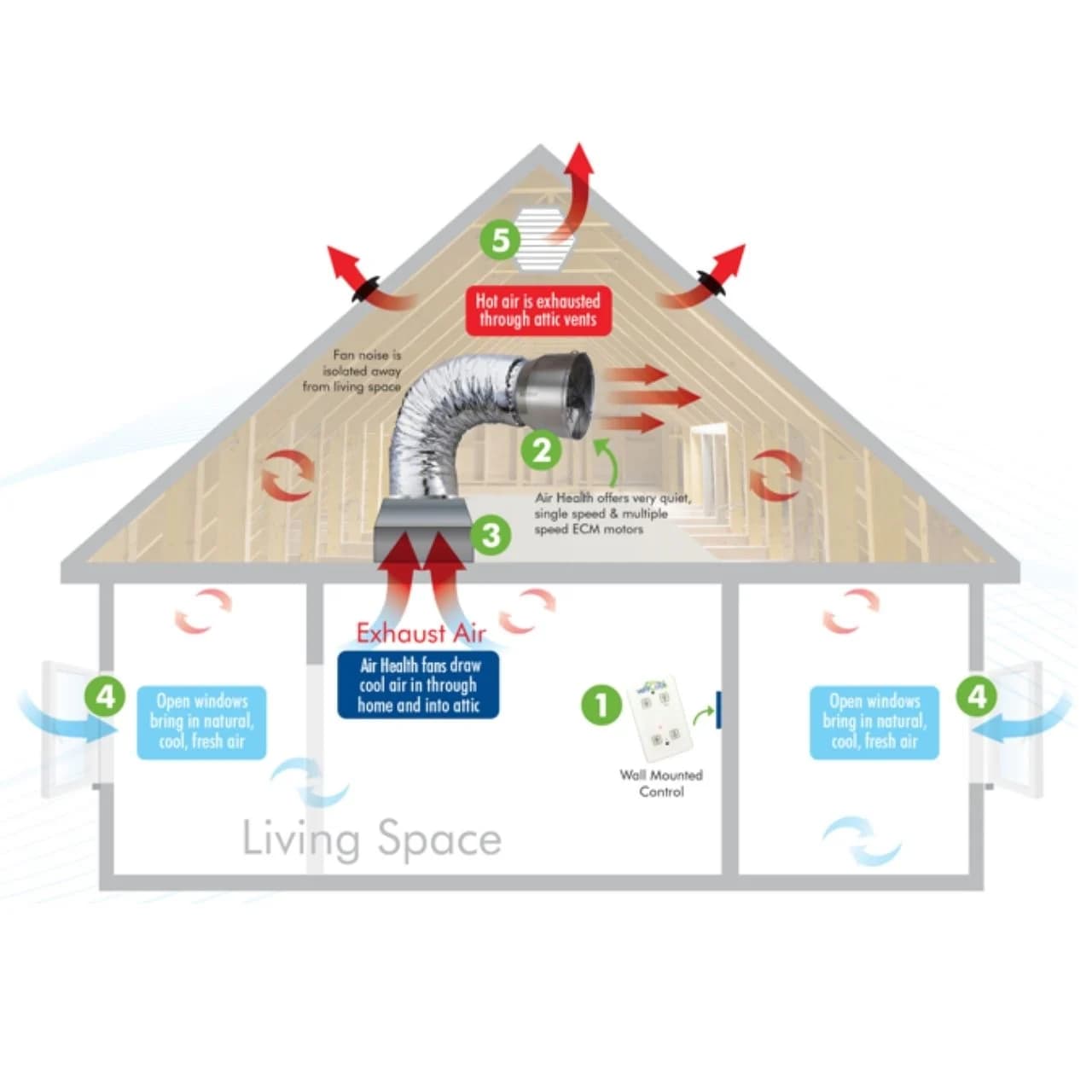
Cascade Series Whole House Attic Fans
Air Health Cascade series whole house attic fans feature economical and reliable Permanent Split Capacitor (PSC) motors. PSC motors operate on up to 60% less energy than traditional air conditioning. Cascade models also feature an exclusive AirLoc Gravity Damper, which has a precise sealing system to isolate the attic from the living space. There are five Cascade fan models with CFM ratings to meet any cooling need.
The Cascade whole house attic fans comes with a 2 speed wall switch (or 4 speed on the 6.5) or upgrade to the WTT 2 speed whole house fan wall control.
The WTT digital 2 speed wall control which includes a timer or a temperature setting. Using the temperature control optimizes your comfort and energy savings by never overcooling your home and only running the fan when needed.
All Air Health whole house attic fans are rated and tested to Home Ventilation Institute Standard HVI-916 and can be used to comply with 2016 Title 24 Part 6.
Everest Series Whole House Attic Fans
Everest Series whole house fans feature a highly efficient Electronically Commutated Motor (ECM) that operates at an optimally low cfm/watt draw consuming up to 90% less energy than traditional air conditioning. All Everest models feature an exclusive AirLoc Gravity Damper, which has a precise sealing system to isolate the attic from the living space. There are five Everest Series house fans to meet any CFM need.
The Everest attic fans comes with a 2 speed wall switch(or 4 speed on the 6.5) or upgrade to the WTT 3 speed whole house fan wall control.
The WTT digital 3 speed wall control which includes a timer or a temperature setting. Using the temperature control optimizes your comfort and energy savings by never overcooling your home and only running the fan when needed.
All Air+Health whole house fans are rated and tested to Home Ventilation Institute Standard HVI-916 and can be used to comply with 2016 Title 24 Part 6.

Frequently Asked Questions
Are whole house fans a good idea?
The cost of running a Whole House Fan is extremely low… like pennies per hour. And because it is so effective at cooling your home and attic quickly, it can be used more intermittently than air conditioning. This means up to a 50-90% savings on electricity costs related to air conditioning.
What is the typical installation cost of a whole house fan?
Installation cost can range from region to region. If you are not planning to install the whole house fan yourself, we suggest getting 3 quotes from your location electrician or contractor.
Who installs the whole house fan?
Installation is easy for any reliable, dependable, and licensed HVAC, Electrical, or Mechanical Professional Contractor.
Will I feel a breeze with a whole house fan?
Depending on the size of your home and the amount of air flow, yes you can get a system that will give you a breeze. A whole house fan(s) designed properly at 15 – 22.5 air changes per hour (ACH) for your home will provide a nice comfortable gentle breeze.
Will a whole house fan also cool my attic?
Yes
What time of day and at what conditions is best to operate a Whole House Fan?
The evening and early morning hours is best for running a whole house fan. These times are typically when outdoor temperature is cooler than inside the home. Any time of day that outdoor temperature is lower than indoor temperature is enough to cool the home.
How long have whole house fans been used for cooling?
Back in the middle 20th century, before affordable central air conditioning, Whole House Fans were used for cooling homes. Whole House Fans in those days were sometimes referred to as attic fans. This type of cooling is known today as ventilation cooling.
Is there a benefit to runing a whole house fan at the same time as a mechanical air conditioner?
No, there is no benefit and the whole house fan should not run simultaneously with mechanical air conditioning. Air Conditioning would be discharged outside the home which would drive up electric usage. Whole house fans are used to lower home temperatures in order to avoid running the more expensive AC system.
How much time does it take to cool down a house with a whole house fan?
How much time it takes to cool down the home depends on many factors including size of home, ceiling height, direction home is facing and number of windows. Every home is different. The greatest cooling benefit will occur when temperatures are cooler outside than inside. Plus, the greater the difference in temperature between outside and inside, the faster the home will cool down.
How do I determine which whole house fan I Need?
There are several variables in determining the fan you will need. Rule of thumb is to base whole house fan selection on the square footage of your home and your specific needs. Proper sizing will take into consideration the whole house in cubic feet (CUFT) and air changes per hour (ACH). See our whole house calculator or see answer below “Will I Feel a Breeze.”
 US Dollars
US Dollars


